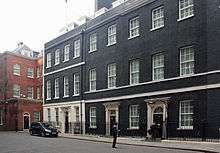11 Downing Street
| Number 11 Downing Street | |
|---|---|
 | |
| General information | |
| Architectural style | Georgian |
| Town or city |
City of Westminster London, SW1 |
| Country | United Kingdom |
| Coordinates | 51°30′12″N 0°07′40″W / 51.503396°N 0.127640°WCoordinates: 51°30′12″N 0°07′40″W / 51.503396°N 0.127640°W |
| Current tenants |
Second Lord of the Treasury (Chancellor of the Exchequer) |
| Construction started | 1682 |
| Completed | 1684 |
| Design and construction | |
| Architect | Christopher Wren |
| Website | |
| http://www.number10.gov.uk/ | |
Listed Building – Grade I | |
| Reference no. | 1356989[1] |
11 Downing Street (sometimes referred to as just Number 11) is the official residence of Britain's Chancellor of the Exchequer (who traditionally also has the title of Second Lord of the Treasury). The residence, in Downing Street in London, was built alongside the official residence of the Prime Minister at Number 10 in 1682.
The first Chancellor to live there was Henry Petty-Fitzmaurice in 1806, but Number 11 did not become the Chancellor's official residence until 1828.[2]
It is currently the official residence of Philip Hammond, who was appointed as Chancellor by Prime Minister Theresa May in July 2016.
Background
Number 11 is part of a charcoal-brick Georgian-era converted mansion, overlooking St. James's Park, that consists—from left to right—of Numbers 12, 11 and 10.
Number 11 is located on the left side of Number 10, the official residence of the Prime Minister (or First Lord of the Treasury) since the early 19th century. Number 12, to the left of Number 11, is the official residence of the Chief Whip, but it is now used as the Prime Minister's press office.
As a result of many internal alterations over the years, the three terraced houses are internally a single complex; one can walk from number 11 to number 10, via an internal connecting door, without using the street doors.
The terraced house was one of several built by Sir George Downing between 1682 and 1684. It was altered c. 1723-35; refaced c. 1766-75 by Kenton Couse and with early C.19 alterations. Along with Number 10, it underwent a major reconstruction by Raymond Erith, 1960-64.[3] Despite reconstruction, the interior retains a fine staircase with carved bracket tread ends and three slender turned balusters per tread. The fine Dining Room of 1825-26 is by Sir John Soane.
Recent occupancy
When Tony Blair became Prime Minister in 1997 he chose to reside in Number 11, rather than Number 10, as it has a larger living area; Blair at that time was living with his wife and their several young children, while Gordon Brown, his Chancellor of the Exchequer, was at that point still a bachelor.[4] In 2007, when Brown became Prime Minister, he at first chose to live in Number 11,[5] but soon moved back to Number 10; Brown was by then married but had fewer children than the Blairs.
Following the 2010 general election, the incoming prime minister, David Cameron, moved into 11, instead of 10 Downing Street, because George Osborne chose to remain in his Notting Hill home.[6] In early August 2011, Osborne moved into Number 10.[7]
Prime Minister Theresa May and Chancellor of the Exchequer Philip Hammond have continued the recent tradition of residing in opposite flats.[8]
References
- ↑ Historic England. "11 Downing Street (1356989)". National Heritage List for England. Retrieved 15 July 2016.
- ↑ "History of Number 11 Downing Street". UK Government. Retrieved 16 October 2014.
- ↑ The Architect and Building News, 25 December 1963
- ↑ "10 Downing Street Today". Archived from the original on 7 June 2007. Retrieved 29 May 2007.
- ↑ Parliament — Ministerial Residences (8 July 2008, updated 13 July 2012)
- ↑ "George Osborne spurns Downing Street to remain a Notting Hill Tory". The Daily Telegraph. 26 June 2010.
- ↑ "Osborne's home front". The Sun.
- ↑ Boris Johnson, Liam Fox and David Davis share Chevening, BBC News, retrieved 18 July 2016
External links
- 11 Downing Street section from the Survey of London online
